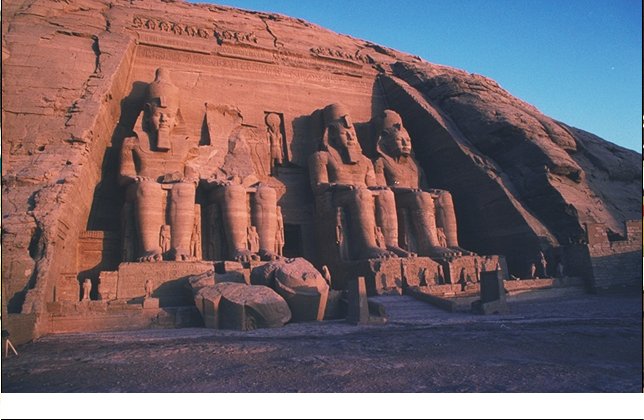|
[ Home ] [ Free Downloads ] [ Favorite Links ]
[ Ramses II ? ]



Some 320 km outside of Aswan, in Nubia, lies the Abu Simbel temple carved directly out
of the sandstone cliffs along the Nile. The fascinating temple that lies here was built by
Ramses II. Although it was really built for his own glorification, theoretically the
temple was dedicated to the Gods Amon Ra, Harmakis and Ptah. The face of the temple
consists of four huge statues of King Ramsis seated on his throne, each statue being 20
meters high, 4 meters from ear to ear and 1 meter across the mouth. The statues of the
three to whom the temple was dedicated, once stood at the heart of the mountain out of
which this temple was carved. Interestingly, twice a year the sun would penetrate the
entrance of the temple into the mountain and shine on Amon Ra and a statue of Ramses II.
It would then move to shine on Harmakis about 20 minutes later but fail to shine on Ptah
who was, in fact, the God of Darkness.
In the Temple's yard, there is a group of monuments, the most important of which is the
famous marital monument on which is registered the story of the marriage of the Pharaoh
and the daughter of the Hethean King; after signing the first peace treaty in the world
between Egypt and Khita.
In the hall of columns, there are eight huge pillars on which is sculptured the statue of
the king taking the figure Osiris, the God of the Dead. This hall is also known for its
northern wall on which is represented the Kadesh battle, which was difficultly won by the
king. As for the southern wall, it also has a dazzling scene representing the king with
his sons attacking the Syrian citadel, and at the bottom of the picture we find a shepherd
trying to escape the victorious king. Just beside this scene, the king is pictured again
holding one enemy in one hand and stabbing him with the other. This specific scene is
remarkable because the enemy appears to be of the same size as the king while in other
scenes enemies were always humiliated by being smaller than the king.
The temple of Abu Simbel contains other scenes of no less importance than the former, such
as the scene of the king with his lion and others featuring the priests.

|
